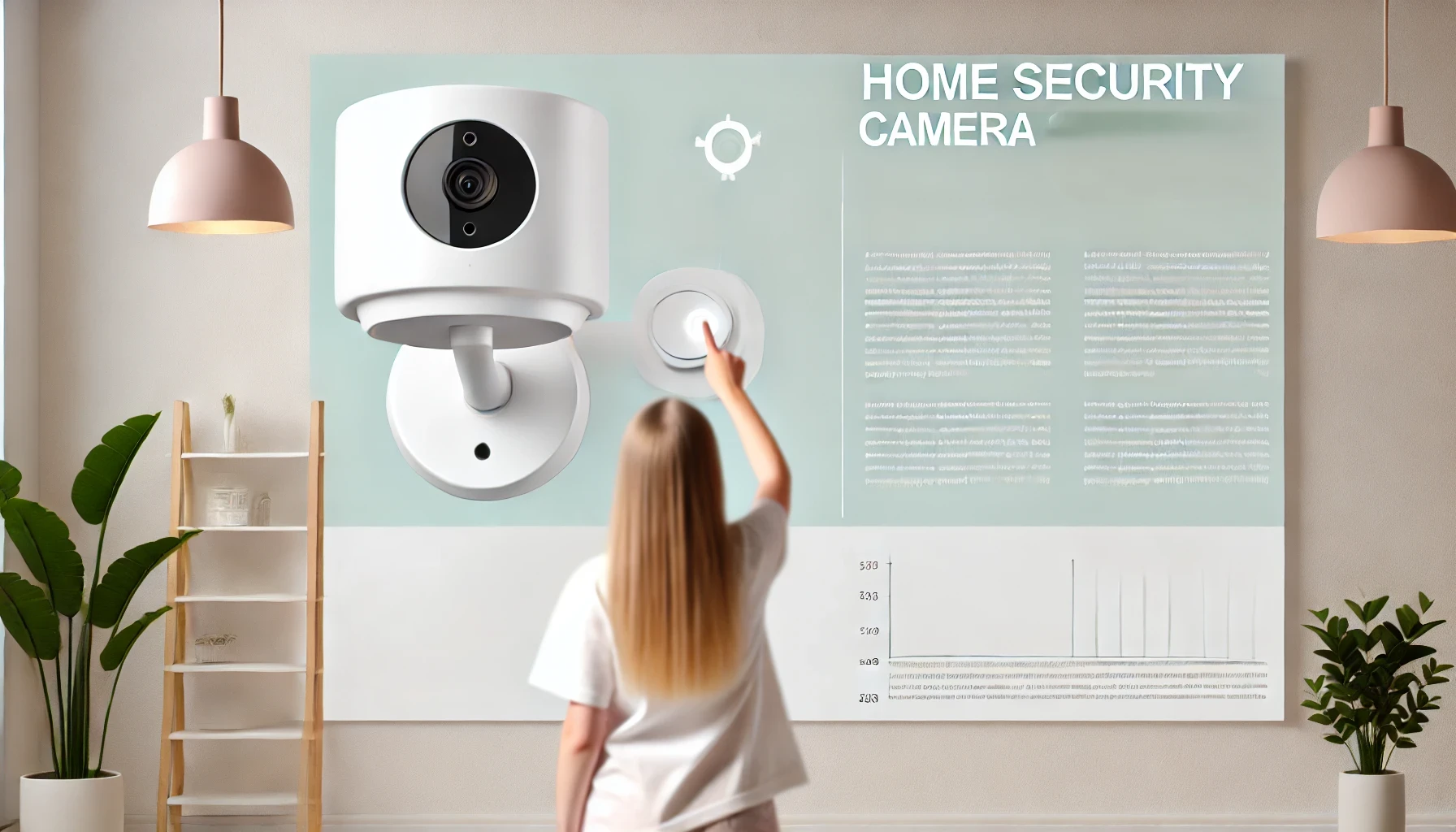Augment Reality Statistics By Market Size, Market Growth, Revenue And Shipment
Updated · Sep 23, 2024

Table of Contents
- Introduction
- Editor’s Choice
- Mobile Augmented Reality Market Size
- Extended Reality Market Size
- Augmented Reality B2C Market Growth
- Virtual Reality Market Growth By Segment
- Augmented And Virtual Reality Headset Shipments Worldwide
- AR/VR Shipments Worldwide By Market
- Virtual Reality Market Growth Total
- Extended Reality Vendors' Market Share
- Comparison Of AR Headsets And Glasses Worldwide By Price
- Comparison Of AR Headsets By Weight
- Estimate Of Economic Value From Manufacturing Of Augmented Reality Iot Devices Worldwide
- Economic Estimate Of AR In IoT-Based Offices
- Economic Estimate Of AR-Enabled IoT Vehicles In The Future
- Augment Reality Market Revenue Worldwide
- Augment Reality Industry Overview
- Conclusion
Introduction
Augment Reality Statistics: Augmented reality refers to the interactive experience that. Enhances the real-life experience of the real world with the help of computer-generated perceptual information. For the most part, it takes the assistance of software and mobile applications and hardware devices such as AR glasses.
Specifically, the concept of augmented reality focuses on creating a digital virtual layer over a real-life environment. This technology provides a strong interactive learning environment for individuals. We will go through the augmented reality statistics to better understand this technology and its impact on different fields.
Editor’s Choice
- The virtual reality market revenue is forecasted to hit USD 62.03 billion by 2029.
- Meta held a 72% market share in XR headset shipments in Q4 2024.
- Microsoft HoloLens 2 is the most expensive AR headset at USD 3,500 per unit.
- The economic value of AR IoT devices is estimated to reach USD 90-110 billion by 2030.
- AR in IoT-based offices could generate USD 30-100 billion in economic value by 2030.
- AR-enabled IoT vehicles are expected to create USD 4-7 billion in economic value by 2030.
- About 60% of online shoppers expressed interest in using AR technology to visualize products in 2023.
- The global AR market was valued at approximately USD 40 billion in 2023.
- AR B2C market revenue is forecasted to reach USD 52.05 billion by 2027.
- Mobile AR market revenue is projected to reach USD 36.26 billion by 2026.
- The extended reality market size is expected to grow to USD 100.77 billion by 2026.
Mobile Augmented Reality Market Size
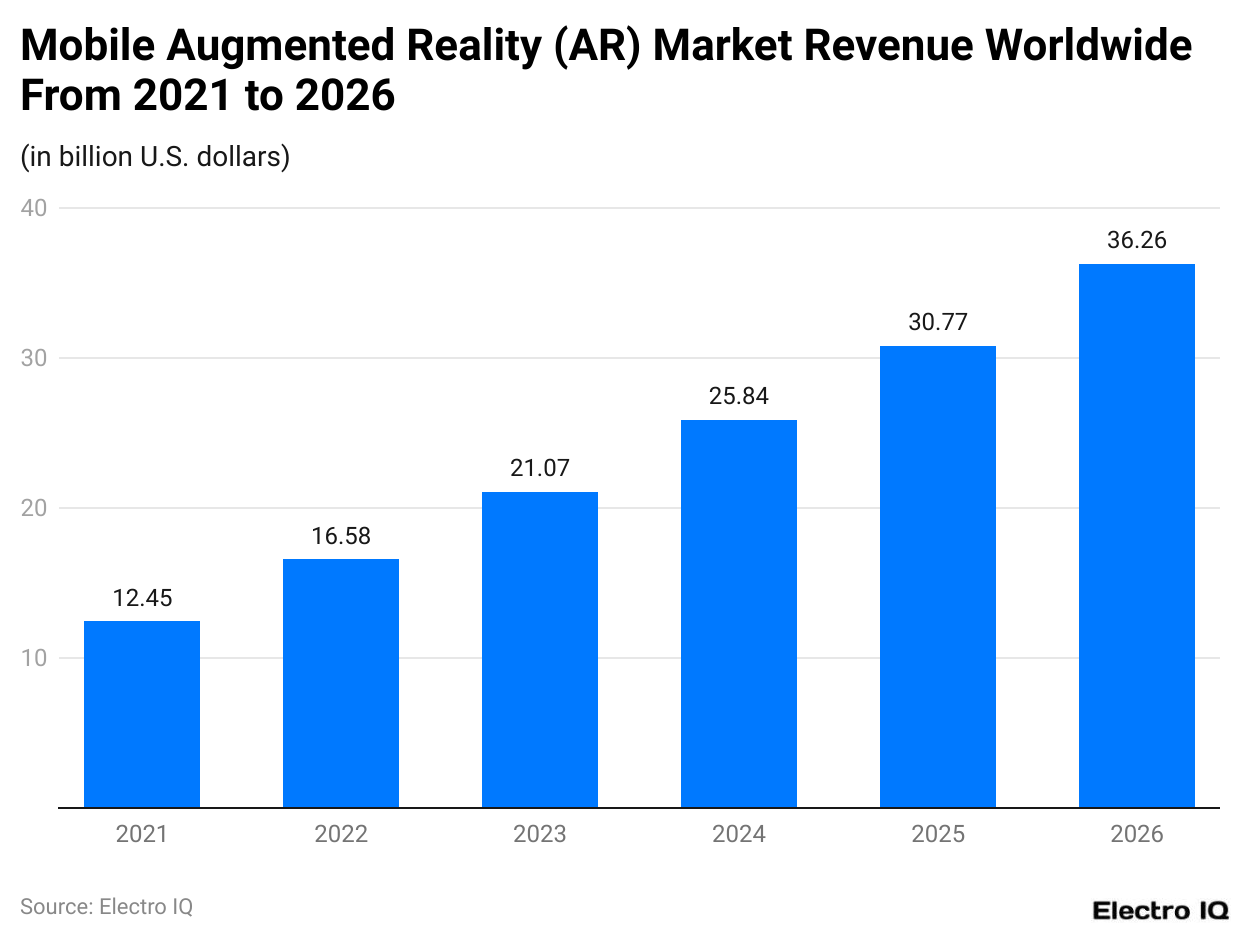
(Reference: Statista.com)
- The augmented reality statistics show that mobile-based augmented reality has grown significantly over the years.
- This could be attributed to the fact that in 2021, mobile augmented reality had a market revenue of $12.45 billion, which increased to $21.07 billion by the end of 2023.
- It is predicted that by the end of 2026, the augmented reality market will have a market revenue of $36.26 billion.
Extended Reality Market Size

(Reference: Statista.com)
- Extended reality is an umbrella term that refers to augmented reality, virtual reality, and mixed reality as different visual technologies.
- The extended reality statistics reveal that visual technology has a growing market size.
- In 2021, the market size was $18.96 billion, which increased to $41.22 billion by the end of 2023.
- It is predicted that by the end of 2026, the market size of extended reality will be $100.77 billion.
Augmented Reality B2C Market Growth
(Reference: Statista.com)
- The augmented reality statistics showcase that it has witnessed a high growth rate in recent years along has a high potential in the coming years.
- In 2017, the market revenue of the AR industry was $8.43 billion, which increased to $31.12 billion by the end of 2023.
- It is predicted that the AR market will have revenue of $52.05 billion by the end of 2027.
Virtual Reality Market Growth By Segment
(Reference: Statista.com)
- The extended reality statistics showcase the decrease in the virtual reality market's market share in all segments.
- In 2020, VR software had a market share of 60.72%, VR Hardware had a share of 39.38%, and VR advertising share of 3.38%.
- By the end of 2023, the market share of VR software had been reduced to 41.11%, VR hardware had been reduced to 23.24%, and VR advertising had been reduced to 6.97%.
- By the end of 2029, VR software will have a market share of 4.92%, VR hardware of 6.92%, and VR advertising of 0.89%.
Augmented And Virtual Reality Headset Shipments Worldwide

(Reference: Statista.com)
- The extended reality statistics showcase that the augmented reality shipment amount is significantly smaller than virtual reality headset shipments.
- As per the Augmented Reality statistics, there were 0.28 million shipments of AR sets, which increased to 0.47 million by the end of 2023. It is predicted that by the end of 2027, there will be 6.41 million shipments.
- In contrast, the size of shipments of virtual reality headsets has been significantly higher, with 9.59 million units shipped in 2023, which is expected to increase to 24.65 million by the end of 2027.
AR/VR Shipments Worldwide By Market
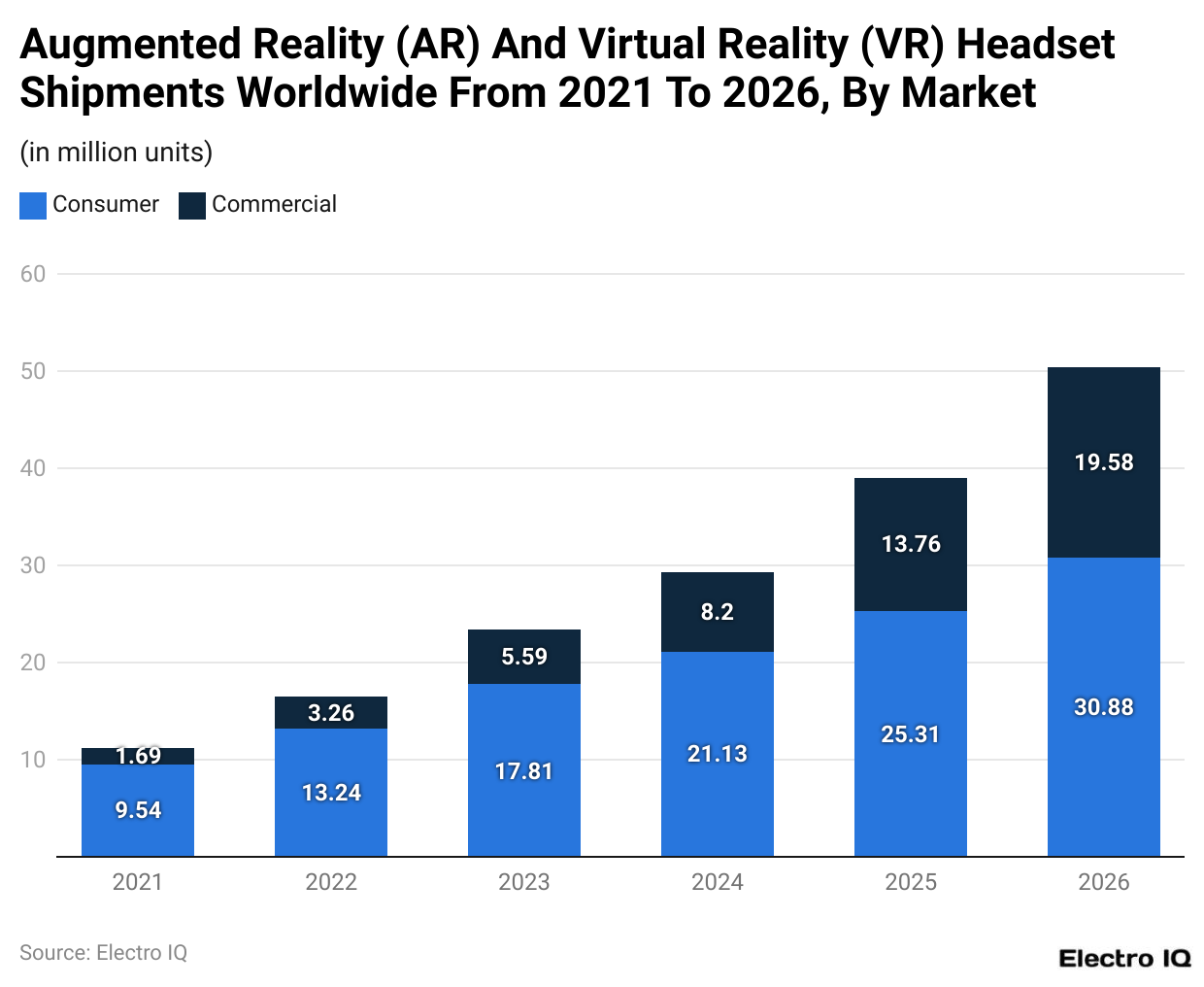
(Reference: Statista.com)
- The augmented reality statistics show that as a combined segment of AR/VR headsets, the majority of shipments are based on consumers, with 17.81 million units by the end of 2023, which is expected to increase to 30.88 million units by the end of 2026.
- By looking at the extended reality statistics, it is evident that the demand for AR/VR segments is consistently increasing.
Virtual Reality Market Growth Total
(Reference: Statista.com)
- The extended reality statistics reveal that the virtual reality market is growing consistently.
- In 2019, the market revenue was $12.68 billion, which increased to $32.08 billion by the end of 2023.
- The augmented reality statistics showcase that by the end of 2029, the market revenue of the virtual reality market is expected to be $62.03 billion.

(Reference: Statista.com)
- The augmented reality statistics showcase that eta, Sony, Pico, HTC, Xreal, and DPVR are major vendors that supply XR-based shipments.
- As per the extended reality statistics by the end of Q4 2024, Meta has a market share of 72%, followed by Sony with 15%, Pico with 4%, and Others with 9%.
Comparison Of AR Headsets And Glasses Worldwide By Price
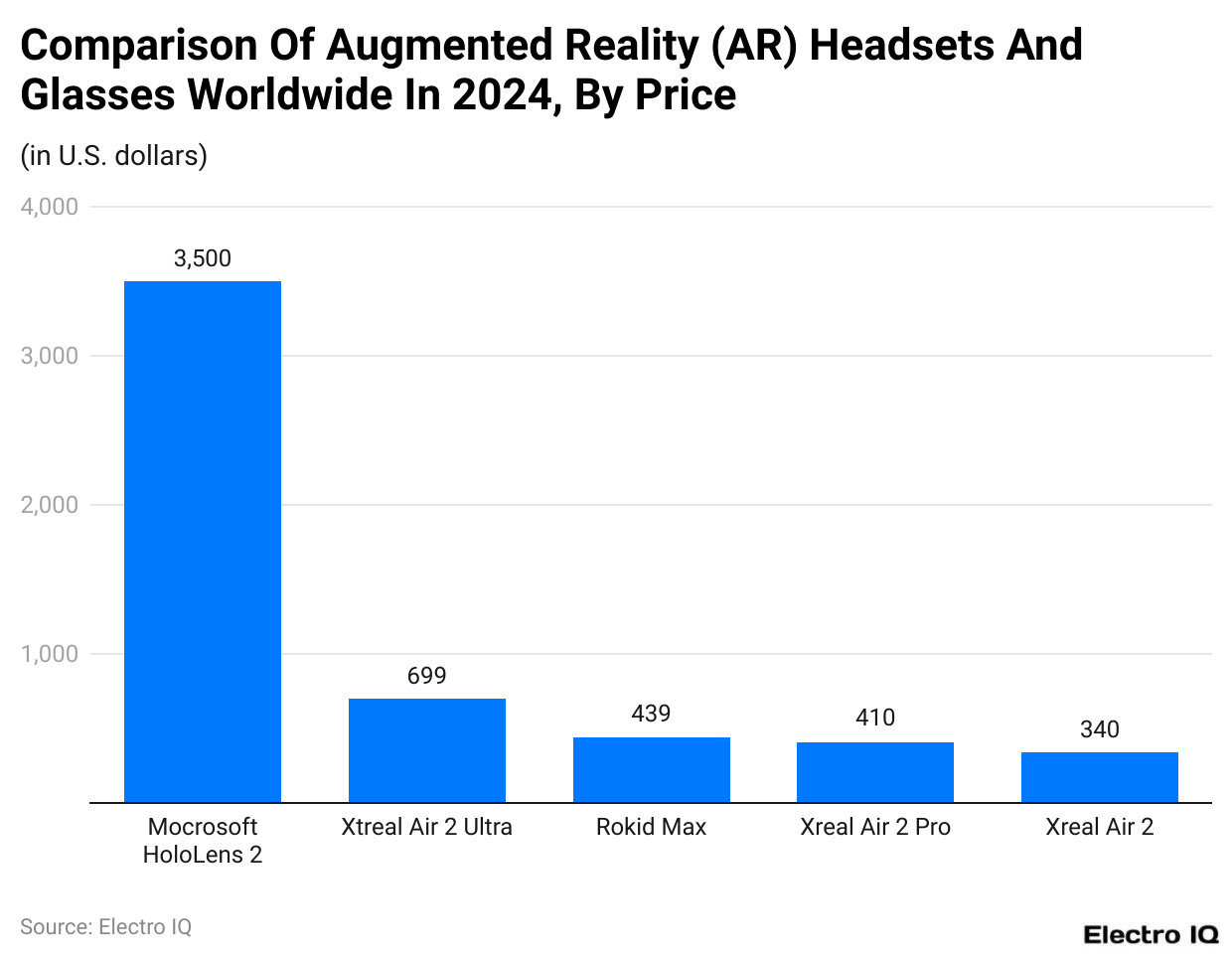
(Reference: Statista.com)
- The augmented reality statistics showcase that Microsoft HoloLens 2, Xreal Air 2 Ultra, Rokid Max, Xreal Air 2 Pro, and Xreal Air 2 are major players in AR headsets and glasses worldwide.
- The extended reality statistics reveal that Microsft Hololens is a significantly high price at $3500 per unit.
- It is followed by Xreal Air 2 Ultra with $699 price per unit, Rokid Max with $439 price per unit, Xreal Air 2 Pro with $410 price per unit, and Xreal Air 2 with $340 price per unit.
Comparison Of AR Headsets By Weight

(Reference: Statista.com)
- The weight of AR headsets is an essential component when it comes to customer satisfaction while using the headset.
- The augmented reality statistics showcase that Microsoft Hololens 2 is the heaviest headset, with a weight of 556 grams.
- The extended reality statistics showcase that following Microsoft Hololens 2, the following are the weight of the prominent AR headsets: Magic Leap 2 with 260 grams, Lenovo ThinkReality A3 with 130 grams, Nreal Air with 79 grams, and Rokid Max with 75 grams.
Estimate Of Economic Value From Manufacturing Of Augmented Reality Iot Devices Worldwide
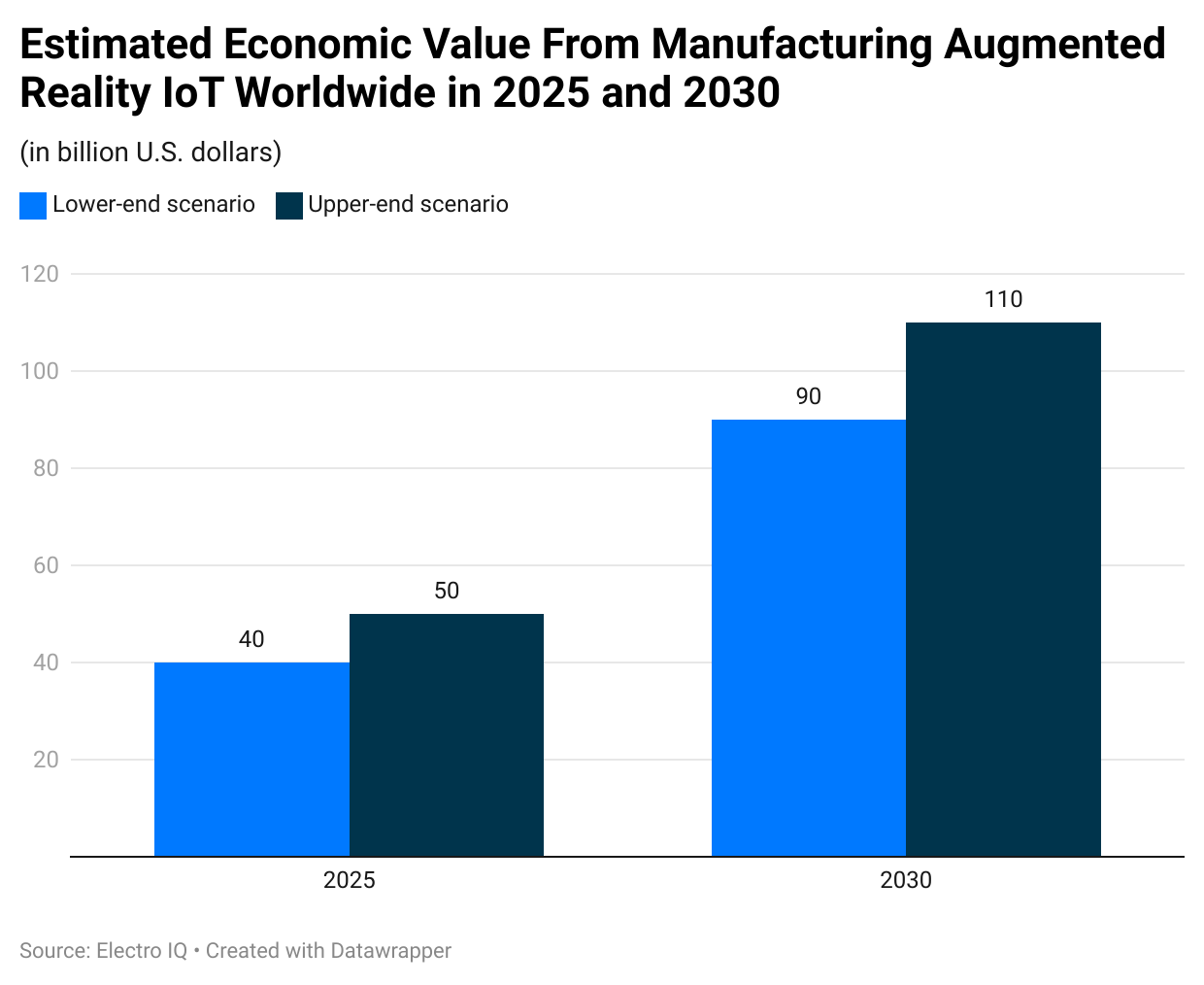
(Reference: Statista.com)
- The Augmented Reality reveals that the economic value of augmented reality-based IoT devices has a prosperous future; hence, it would be interesting to go through its estimated economic value worldwide
- By the end of 2025, the economic value of augmented reality-based IoT devices will range between $40 billion and $50 billion.
- In 2030, the extended reality statistics show that the economic value of augmented reality-based IoT devices is expected to range between $90 billion to $ 110 billion.
Economic Estimate Of AR In IoT-Based Offices

(Reference: Statista.com)
- The application of augmented reality-based IoT devices is expected to play a major role in ensuring productivity in offices.
- As per the extended reality statistics in 2025, the estimated economic value of IoT-based devices will range between $10 billion to $40 billion.
- The economic value of IoT-based devices is expected to range between $30 billion and $100 billion by the end of 2030.
Economic Estimate Of AR-Enabled IoT Vehicles In The Future

(Reference: Statista.com)
- Augment reality statistics showcase that there is a huge scope for augmented reality-based IoT products in the future.
- The extended reality statistics showcase that in 2025 the economic value of Augmented Reality vehicles is expected to range between $2 billion to $3 billion 2025.
- By the end of 2030, it is expected that Augmented Reality will range between $4 billion and $7 billion.
Augment Reality Market Revenue Worldwide
(Reference: Statista.com)
- The augmented reality statistics showcase that there is a significant increase in the market revenue in the B2C market.
- In 2019, the revenue from augmented reality advertising was $1.43 billion, which increased to $4.44 billion by the end of 2023.
- It is predicted that by the end of 2029, the augmented reality advertising revenue will be $8.03 billion.
Augment Reality Industry Overview
Augmented Reality (AR) has become one of the fastest-growing technologies, influencing various industries such as gaming, healthcare, retail, and education. The growing demand for more immersive and interactive experiences has fueled the AR market’s rapid growth. From a market researcher’s point of view, understanding Augmented Reality Statistics in 2023 and 2024 is key to predicting future trends, identifying investment opportunities, and offering insights to companies looking to leverage AR.
In 2023, the global AR market was valued at approximately $40 billion US dollars. This figure highlights the significant demand for AR applications, especially in industries like gaming and retail. For example, in the gaming industry, AR allows players to merge the digital world with real-life environments, creating more engaging experiences. Similarly, retailers use AR to enable customers to try products virtually before making purchases. The technology provides a competitive edge by improving customer experience, which explains the strong market growth in these sectors.
By 2024, the AR market is expected to grow even further, reaching an estimated $60 billion US dollars, a clear indication of its increasing influence across multiple sectors. This growth represents an increase of around 50% from the previous year. The impressive expansion of AR is attributed to technological advancements such as better hardware, faster internet speeds, and the integration of AR into mobile devices. With major tech companies like Apple, Google, and Microsoft heavily investing in AR, the technology’s penetration in everyday consumer devices is bound to rise.
One of the most important Augmented Reality Statistics to highlight is the annual growth rate. The AR market is expected to grow at a CAGR (Compound Annual Growth Rate) of 35% between 2023 and 2028. This high growth rate demonstrates the expanding role of AR in areas like training, remote assistance, and healthcare. For instance, in the healthcare sector, AR is being used for medical training and assisting surgeons during complex procedures. The ability to overlay digital information in real time can drastically improve decision-making and outcomes in these fields, driving further adoption.
Another key trend contributing to AR's growth is its integration into e-commerce. In 2023, about 60% of online shoppers expressed interest in using AR technology to visualize products before purchasing. This interest is expected to rise in 2024 as more companies adopt AR solutions to improve the shopping experience. From trying on clothes to seeing how furniture fits in a room, AR allows consumers to make more informed decisions, reducing return rates and boosting overall customer satisfaction.
The rise of augmented reality in marketing is also noteworthy. In 2023, brands using AR in advertising campaigns reported up to 20% higher engagement rates compared to traditional digital ads. As AR technology becomes more accessible, it is expected that more companies will include AR in their marketing strategies in 2024. This will allow them to create interactive, engaging content that captures the attention of consumers in new and innovative ways.
Looking forward, AR’s role in education is set to grow significantly. In 2023, about 30% of educational institutions adopted some form of AR to enhance learning. By 2024, this figure is expected to rise as AR tools become more affordable and widely available. Augmented Reality allows students to interact with 3D models and simulations, making learning more interactive and engaging. This trend could revolutionize education, making it more effective and accessible.
Conclusion
Augment reality has emerged to have a transformative effect in a variety of sectors. The AR market is experiencing rapid expansion, with projections indicating substantial increases in market size, revenue, and adoption rates. As per the Augmented Reality statistics, this technology has been instrumental in creating value creation in manufacturing, office environments and vehicle integration-based industries. However, challenges remain, including the need for more affordable and lightweight AR devices, as well as continued innovation in content creation and user experience. Nevertheless, as major tech companies continue to invest in the development of this technology, the future seems bright.
FAQ.
The mobile AR market is projected to reach $36.26 billion by 2026.
Extended reality is an umbrella term for AR, VR, and mixed reality technologies.
AR headset shipments are projected to reach 6.41 million units by 2027.
Meta held a 72% market share in XR headset shipments in Q4 2024.

Aruna Madrekar is an editor at Smartphone Thoughts, specializing in SEO and content creation. She excels at writing and editing articles that are both helpful and engaging for readers. Aruna is also skilled in creating charts and graphs to make complex information easier to understand. Her contributions help Smartphone Thoughts reach a wide audience, providing valuable insights on smartphone reviews and app-related statistics.









